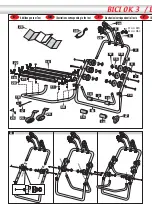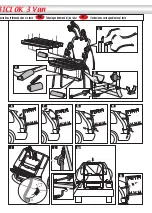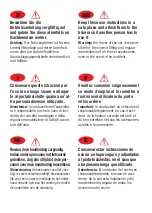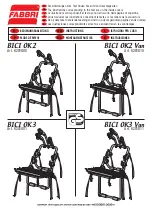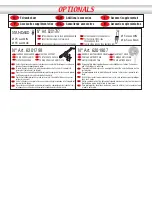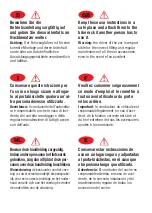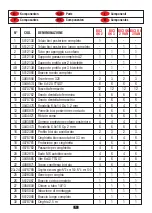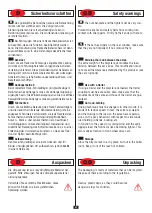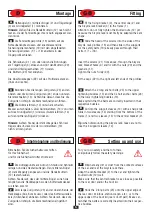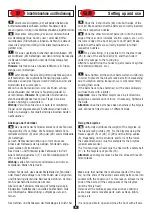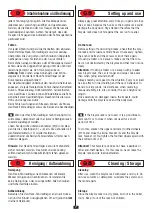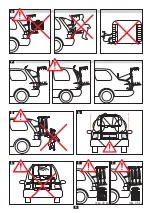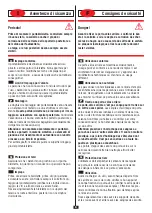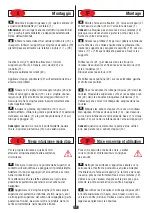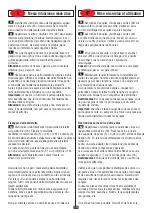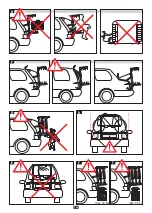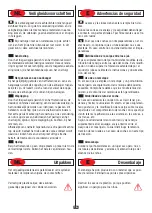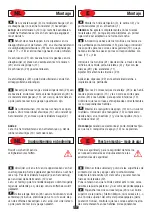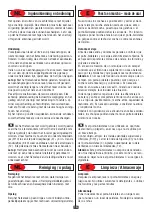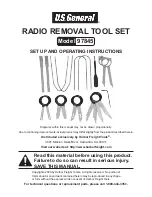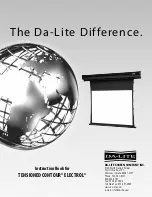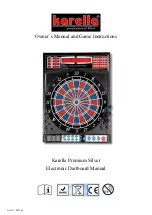
Zwei kurze Zurrgurten (24) auf beiden Seiten des
Kofferraumdeckels einhaken. Achten Sie darauf, dass
die Zurrgurten richtig in die Klemmschnallen eingeführt sind.
Zwei kurze Zurrgurten (24) an der unteren Kante
der Heckklappe (Bus, Kombi, usw.) oder des Koffer-
raumdeckels (Stufenheck) einhaken. Achten Sie darauf
dass die Zurrgurten richtig in die Klemmschnallen ein-
geführt sind.
Für eine zusätzliche Sicherheit den Stahlhaken (25)
am Gurtband (24) befestigen und dann mit der Karosserie
im Bereich Abschlepploch unter der Stossstange fest
verankern.
Hinweis:
Die Haken nie an Kunststoffteilen (z.B. Stoss-
stange usw.) befestigen.
Jetzt können Sie alle Zurrgurten gleichmässig und
satt festziehen. Als zusätzliche Sicherung gegen selb-
ständiges Lösen des Trägers durch Vibrationen sind alle
Gurtenden fest zu verknoten.
Wenn Sie die Gurten kürzen, sind die Enden schräg
abzuschneiden und mit einem Feuerzeug wieder zu
verschmelzen.
Hinweis:
Bei gekürzten Gurtenden be-
steht keine Möglichket mehr, den Träger bei einem
anderen Autotyp zu montieren.
Wichtig:
Versuchen Sie den am Auto fest montierten
Träger unter angemessenem Kraftaufwand nach allen
Seiten zu bewegen. Eventuell sind die einzelnen Gurten
nachzuziehen.
Anbringen der Fahrräder
Das Gewicht der Fahrräder korrekt auf die Fahrrad-
trägerprofile (16) verteiler. Die Fahrräder mittels Fahr-
radrahmen-Halter (5) oder (26) oder (29) sowie Halteseile
(6) befestigen.
Je nach Rahmenkonstruktion und -form muss die
Grösse der Halteseile den jeweiligen Fahrrädern ange-
passt werden (Extrazubenör).
Das Vorder- und Hinterrad jedes Fahrrades sind mit
einem Sicherungsriemen (17) am Fahrradträgerprofil
(16) zu befestigen.
Wichtig:
Jedes Fahrrad muss mindestens an drei ver-
schiedenen Stellen fixiert sein.
Achten Sie darauf, dass weder Metallteile der Fahrräder
oder Heck-Fahrradträger noch die Enden der Zurrgurten
und Sicherungsriemen die Karosserie berühren. Verkno-
ten Sie deshalb die Gurtenden immer.
Alle Teile der Fahrräder müssen gut festgezogen sein.
Kindersitze, Satteltaschen und alle abnehmbaren Teile
wie Trinkflasche, Beleuchtung, Luftpumpe usw. ent-
fernen.
Das Oeffnen und Schliessen der Heckklappe ist nicht bei
M
L
I
H
G
Hook the 2 short belts (24) onto both sides of the
boot lid. Make certain that the belts are correctly inserted
into their respective buckles.
Hook the other two short belts (24) onto the lower
edge of the rear door (minibus, station wagon, etc.), or to
the lower edge of the boot lid (rear cut-off part). Make
certain that the belts are correctly inserted into their
respective buckles.
For a safer fixing, it is possible to fix the steel hook
(25) to one of the anchor belt (24), and then hook it
under the bumper to the towing lug.
Attention: avoid fixing the hooks to parts made of synthe-
tic material (bumpers, etc.).
Now, tighten all the anchor belts well and uniformly.
In order to prevent the bicycle rack belts from slackening
due to vibration during transport, we recommend firmly
knotting their ends.
If the belts have to be shortened, cut the ends obliquely
and fuse them with a lighter.
Important:
move the fitted bicycle rack in all directions,
applying a small amount of force. If necessary, tighten all
the belts.
Attention:
once the belts have been shortened, the bicycle
rack cannot be fitted to cars of different kinds.
Fixing the bicycles
Uniformly distribute the weight of the bicycles on
the bicycle rack profiles (16). Fix the bicycles using the
frame support (5) or (26) or (29) and the fixing cables
(6). Depending on the structure and form of the frame,
the cable dimensions must be suitable for the bicycles
(special accessories).
The front and rear wheels must be fixed with a safety belt
(17) to the bicycle rack profile (16).
Attention:
each bicycle must be fixed in at least three dif-
ferent places.
Make sure that neither the mechanical parts of the bicy-
cle, nor the ends of the anchor and safety belts come into
contact with the bodywork. For this reason, always tie the
ends of the belts. All the components of the bicycles
must be firmly fixed.
Remove all the mobile accessories such as children’s
seats, bags and removable parts such as flask, lights,
pumps, etc.
It is not possible to open and close the boot with all cars.
M
L
I
H
G
6
Inbetriebnahme und Bedienung
Setting up and use
D
GB
Summary of Contents for 6201800
Page 4: ......
Page 8: ......
Page 14: ...P O Q R S T max 30 kg T max 45 kg 2 ...
Page 20: ...P O Q R S T max 30 kg T max 45 kg 8 ...
Page 26: ...P O Q R S T max 30 kg T max 45 kg 14 ...
Page 32: ......


